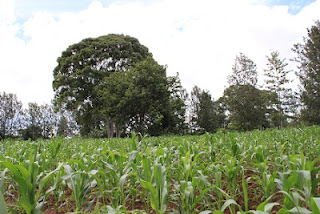Sometimes people ask
what we eat when visiting Burundi. I've briefly described a few meals
on some earlier blog posts, but here I would like to be a bit more
comprehensive.
Most Burundians eat a
simple diet of a starch and a vegetable most days. This could take
the form of rice and beans or bananas and peas. And there is always
sauce. The most common sauce that we have encountered seems to be
made from tomatoes and onions and some hot pepper, all added to water that has been used to boil meat. We have also eaten
a delicious peanut sauce, which is a good source of fibre and
protein.
When I mention bananas,
I don't mean what most Canadians understand by the term. Broadly
speaking there are two kinds of bananas in Burundi, with several
sub-types. The first is a starch rather than what we usually see in
Canada. This is a staple that can be eaten in a variety of ways,
often roasted or fried. Deep-fried bananas make a tasty alternative
to french fried potatoes. This kind of banana (which is not quite the
same as a plantain) is very common in Burundian cuisine. The second
type of banana is what is referred to here as “sweet bananas”,
and is the familiar fruit eaten in Canada, though often much smaller
than those we import from Central America. It is common to see sweet
bananas about 10 cm long. (There is actually a third type of banana
which is used to make beer. Delicious but potent!)
Most Burundians eat
meat about once per week. Meat could be chicken, beef, pork, goat, or
rabbit. Fish is also popular. Much of the fish eaten in Burundi comes
from Lake Tanganyika. Other animals are raised locally. We often
encounter them along the roadside.
Staples include
bananas, potatoes, sweet potatoes, cassava, maize and peanuts.
Cassava is a versatile plant. The root can be eaten as a starch, or
made into flour from which bread can be made. And the leaves can also
be eaten as a vegetable, high in iron. Vegetables that we have
encountered include peas, beans, beets, spinach, tomatoes, onions,
hot peppers (scotch bonnets) and avocados.
Fruits are also
plentiful in Burundi. We have seen sweet bananas, pineapples,
jackfruit, apples, passion fruit, papaya, and mangoes.
 |
| Peanuts |
Burundi is also a large
producer of palm oil, sugar cane, coffee and tea, which are major
export products.
 |
| Coffee |
Burundians live the 100-mile diet in that they truly eat what is produced locally. In fact, they probably go beyond the 100-mile diet to the 10-mile diet. Much of what people eat is what they grow themselves. It is normal to see houses in villages or along the rural roads with bananas and other foodstuffs growing alongside them, and we often see larger plots of land being cultivated. And we often see people tending a few cattle or goats. It seems that very little of the Burundian countryside is not cultivated. Excess produce is taken to the local market to sell, carried on the head or on bicycles.
 |
| Avocado tree |
Describing flavour is a
bit of a matter of taste, but I find Burundian food very tasty. It is
mildly spicy to my taste, with balanced flavours.








No comments:
Post a Comment